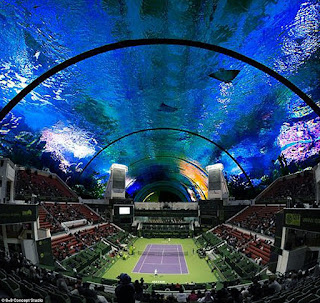Even though the most famous underwater city of all, Atlantis, is probably a myth, there are a number of well-known submerged metropolises around the world. Some of these cities are well known to history, while others are mysterious and unexplained.
For most of human history, these communities were lost to view, but today diving equipment, robots, submarines, and underwater cameras bring them back to life. Today archeologists, tourists, historians, and others can visit and explore underwater cities much as they explore ruins or abandoned communities. Every day more and more underwater cities are giving up their treasures.
Here is a documentary named "Sunken Civilizations: Secrets of Lost Cities Underwater", from which you can visit some amazing underwater cities with the divers.
1 Pavlopetri, Greece
Nobody knows what the real name of this community is because it sank into the waters off the southern tip of Greece's Peloponnese peninsula 5,000 years ago. Pavlopetri, or Peter and Paul's stone, is the modern name for the inlet where the ruins are submerged. The ruins were discovered in 1967 and were found to contain an almost complete community, including streets and tombs. Nobody knows who built the town. It was originally assumed to be part of the Mycenaean civilization, but archeologists now believe it is older and possibly Minoan in origin. Historians think Pavlopetri might have been destroyed by an earthquake that destroyed the Minoan civilization on Crete around 1000 BCE.
2 Port Royal, Jamaica
The city at the mouth of Kingston Harbor was once a famous base for pirates and privateers. The pirates used Port Royal as a base to raid the treasure ships of the famed Spanish Main. At one time pirates from all over the world gathered in the city under the protection of the notorious British governor and pirate Sir Henry Morgan. At its height in the late 17th Century, Port Royal contained four forts and 2,000 buildings. Famous visitors included notorious pirates like Calico Jack, Charles Vane, and Blackbeard. Most of Port Royal sank beneath the Caribbean in an earthquake in 1692. The city sank because the silt it was built on gave way during the earthquake. Modern archeologists have discovered that much of the city, including pirates' taverns, docks, and ships are still preserved under Kingston Harbor.
3 Dwarka, India
This ancient city was considered a myth until divers discovered ruins off the coast of the Indian state of Gujarat in 2000. The Hindus believe that Dwarka was built by Lord Krishna and once contained 70,000 palaces. Researchers from India's National Institute of Ocean Technology found the ruins in the Gulf of Khamabhat. Nobody knows who built the cities submerged in the Arabian Sea. The ruins could be some of the oldest in the world: carbon dating has revealed that wood dredged from the site dates to around 7400 BCE, or around 9,000 years ago, predating any known civilization. It is not known how or why the city sank, but scientists believe the Arabian Sea was 100 meters lower than its current level as recently as 2,000 years ago.
4 The Pyramid of Yonaguni or Yonaguni Monument, Japan
Like Dwarka, the submerged pyramid off the Japanese island of Yonaguni has created controversy. Divers discovered the "pyramid" with staircase-like terraces in 1986. Since then some scientists have labeled it a rock formation, but Masaaki Kimura, a seismology professor, believes that it was built between 2,000 and 3,000 years ago. That means it predates any known Japanese civilization if it really is manmade. The design of the pyramid is similar to those found in Mexico and Central America. The pyramid is very mysterious because there are no other underwater structures in the area.
5 Lion City, China
Even though this city is over 1,400 years old, it has only been submerged for less than 60 years. Lion City was flooded in 1959 when the Chinese government built a hydroelectric dam on the Xin'an River and created Qiandao Lake. The city, also called Shi Cheng, dates to 621 AD. Lion City is now popular with divers because it has been shown to be largely intact. Shi Cheng is a fairly large city with over 265 arches and five towers on the walls around the city. Another submerged city under Qiandao Lake is believed to be even older: He Cheng might date back the Dong Han Dynasty, which ruled from 25 to 200 AD.
6 Heracleion or Thonis
This submerged city could be one of the world's oldest cities. It might date as far back as 1200 BC. At one point, Heracleion was Ancient Egypt's main port, while today it is submerged in the harbor of modern day Alexandria. The city features in many legends: Hercules was supposed to have visited the city and gave it its Greek name, and Helen of Troy may have also dropped in for a visit. Heracleion was built on islands in the Nile Delta. It probably sank in the third or fourth century BC because the river washed away the silt it was built upon. At one time scientists thought that Heracleion and Thonis were separate cities. Historians only realized they were the same place when divers located the city in 2000.
7 The Temple Under Lake Titicaca, Peru
The world's highest submerged city might lay beneath the waters of Lake Titicaca on the Peruvian-Bolivian border, the world's highest lake in elevation. Lake Titicaca is 12,507 feet in elevation, and it is the largest lake in South America. Archeologists located the temple in 2000 after following a submerged road. The 200-meter-tall temple is thought to be 1,000 to 1,500 years old. It probably predates the Inca Civilization and may have been built by a people called the Tiahuanaco people. Its discovery seems to confirm Inca legends that their civilization began on the lake. It is not known why the temple sank or if there are more submerged buildings in the area.
8 Villa Epecuen, Argentina
This Argentine town might be the world's newest submerged city. During the 1970s it was a thriving community with 5,000 residents and 300 businesses. It sank beneath the bodies of a lake called Lago Epecuen in the late 1980s and early 1990s. Recently the waters have receded, revealing a ghostly landscape that includes playgrounds, trees, utility poles, and dozens of houses. Today there's only one resident named Pablo Novak, a former resident who moved back after the water started to recede in 2009.
9 Ontario's Lost Villages
You don't have to travel far to find submerged communities—simply go to Ontario near the New York border. Ten small Canadian villages disappeared beneath the water when the Saint Lawrence Seaway was built in the late 1950s. Some structures from the towns were moved to Ault Park and an Upper Canada Village to serve as monuments when the area was flooded. The flooded region in the townships of Cornwall and Osnabruck include a portion of the Cornwall Canal. Sidewalks and building foundations can be seen from the shore. The flooded area also includes Crysler's Farm, where a major battle between American and British-Canadian forces was fought during the War of 1812.























































